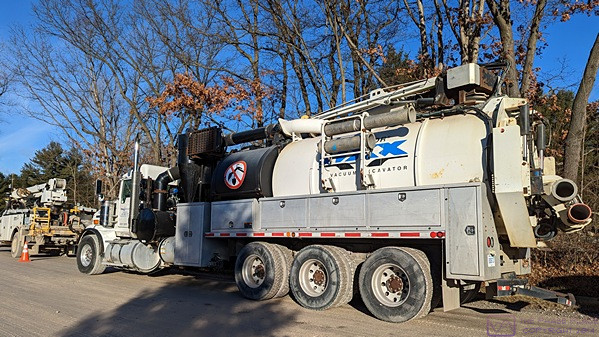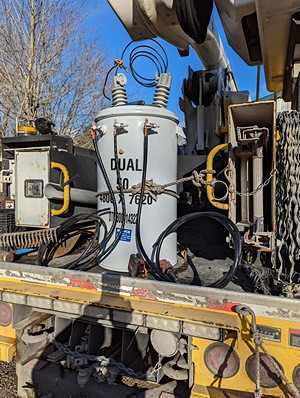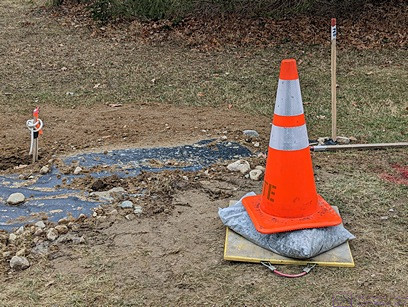[ There are 6 photos in this post. ]
WEDNESAY 18 January
Without any notification, a 4-person DTE crew showed up around 9 AM with three huge trucks and a pick-up truck. I presumed they were here to start replacing the existing utility pole and transformer that feeds our house with a new, taller, pole and a new, (much larger), transformer, as this new transformer will now also supply power to the new barn. I bundled up and went out to introduce myself. I would hang with them for the duration of their visit, chatting with them about the work and taking photos.
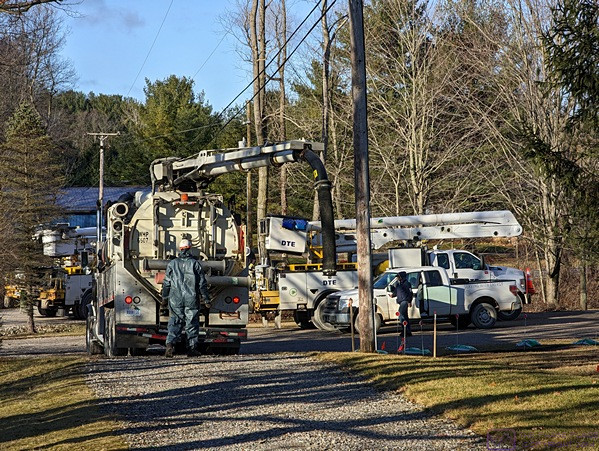
The hydrovac truck in position by the existing utility pole. Some of the DTE trucks are also visible.
One of the trucks was a crane with an auger, but they did not use it. They had to dig a hole for the new pole close to the existing pole, which meant it would also be close to the existing underground service conductors from the house. In this situation, they prefer to dig the hole with a “hydrovac” (water jet / vacuum) truck. Even though the location of the underground wires had been marked by MISS DIG, the DTE crew said the marker flags can be off by several feet from the actual cable location. Ditto for the underground AT&T cable. DTE uses a contractor for the hydrovac work, and a truck was on the way from Roseville on far east side of the Detroit Metro Area. (We are on the far west side of the Detroit Metro Area).
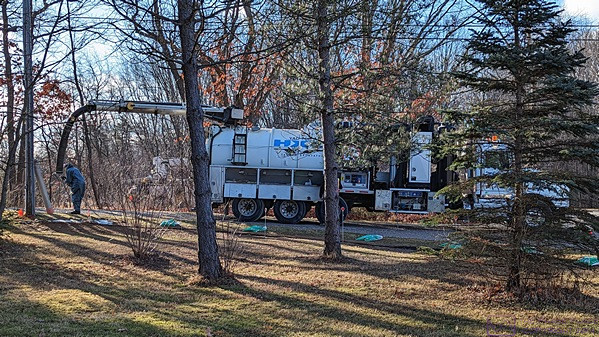
Operating the hydrovac truck is a 2-person job; one of them controls the high-pressure sprayer and vacuum tube, while the other one controls the equipment at the truck.
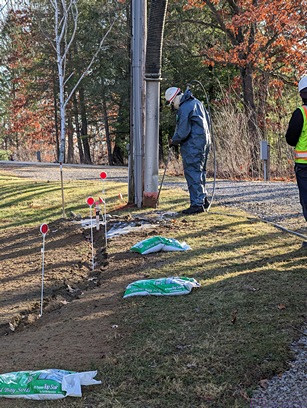
The first 12” of the vacuum tube (orangish color) is a hard metal collar with a fairly keen edge, allowing it to “cut” into the ground while retaining its circular shape as the dirt is loosened by the high-pressure water spray.
The hydrovac truck eventually arrived, got positioned to do the work, and proceeded to dig a 6.5-foot-deep hole some 12” – 16” in diameter, about 30 inches to the west of the existing pole. As the dirt was blasted loose, the vacuum hose sucked it up, along with anything/everything that came loose, including some larger rocks.
It took at least 90 minutes to dig this hole, which surprised me, but the operators worked carefully to get it right. There wasn’t much for the DTE crew to do while they waited for this hole to be dug. One of the bucket trucks, however, had the new 50 KVA transformer, and that crew member went ahead and prepared/attached the small conductors that would go from the primary taps to the distribution wires and the large conductors that would go from the secondary taps to the “rack” below the transformer on the new pole.
[ As an aside, we have two main load centers in our house, a 200 Amp panel in the basement and a 100 Amp panel in the garage. Although we would never draw the maximum combined amperage of 300 Amps, even at an 80% derated current of 240 Amps these panels represent the possibility of a 57,600 VA (Watt) load on the transformer. The barn has a 200 Amp main load center, which at an 80% derated current of 160 Amps, represents the possibility of another 38,400 VA of load. Combined with the house, that would be a possible 96 KVA load. The existing transformer is a 10 KVA unit, and is being replaced with a 50KVA unit. This will be a good size, in my opinion, but not overkill. ]
(The distribution voltage is 13,200 Volts (13.2 KV), but the current through the primary coil of the transformer is relatively low, so the wires do not have to be very large. If the transformer was operating at its maximum rating of 50,000 Volt-Amps (50 KVA), the current in the primary wires would be about 3.8 Amps. By comparison, the voltage between the two “hot” secondary taps is 240 Volts. If the secondary was supplying the full rated capacity of 50 KVA, the current in the secondary conductors would be about 208 Amps. That amount of current requires really big wires.)
In what was the first of several “comical” events (from our point of view), the crew was scheduled to be at a required training session in Pontiac at noon, at least a 30 to 40-minute drive from our house. They left sometime after noon and headed there. Things got done, but far less than if they had been able to stay and work. As they prepared to leave, they said they would be back the next day.
I was pleased and excited that the work had finally begun. I e-mailed our planning consultant, as he had indicated early on that I should let him know as things happened and send a few photos. The reply I got was, essentially “what?”
…
